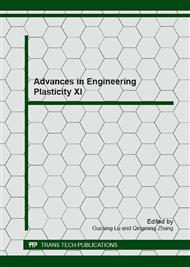p.373
p.377
p.381
p.385
p.389
p.393
p.397
p.401
p.405
Energy Absorption Characteristics of CFRP Double Hat-Shaped Section Member with Various Stacking Condition under Axial Loading
Abstract:
Transport is the safety and comfortableness during the transportation of passenger to desired location. Therefore, goals in transport design can be summarized as environment-friendliness and safety. Demand for weight reduction of transport has been growing in order to solve the environmental problems. In many countries, environment conservation forces the enhanced regulation on gas mileage and emission gas due to exhaustion of energy resource, adding an extra weight of environment pollution. CFRP(Carbon Fiber Reinforced Plastic) which the advanced composite materials has a widely used in lightweight structural materials of aircraft, ship and vehicle because of high strength and stiffness. In this study, collapse mode and energy absorption capability double CFRP hat-shaped section members were analyzed. The stacking condition were selected to investigate the effect of the fiber orientation angle (±15°, ±45°, 90°, 90°/0°and 0°/90° where 0°direction coincides with axis of the member)on the energy absorption of the CFRP double hat-shaped section members. The collapse mode and energy absorption capability of CFRP double hat-shaped section members was analyzed according to the change of the fiber stacking condition of CFRP.
Info:
Periodical:
Pages:
389-392
Citation:
Online since:
January 2013
Authors:
Price:
Сopyright:
© 2013 Trans Tech Publications Ltd. All Rights Reserved
Share:
Citation:


